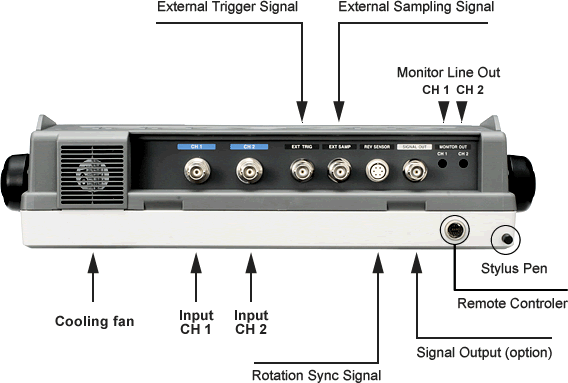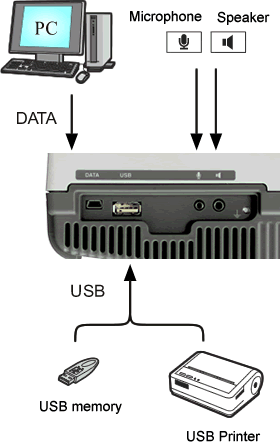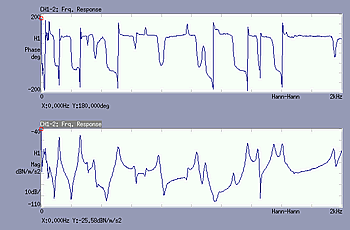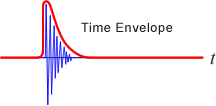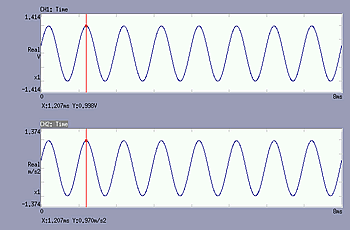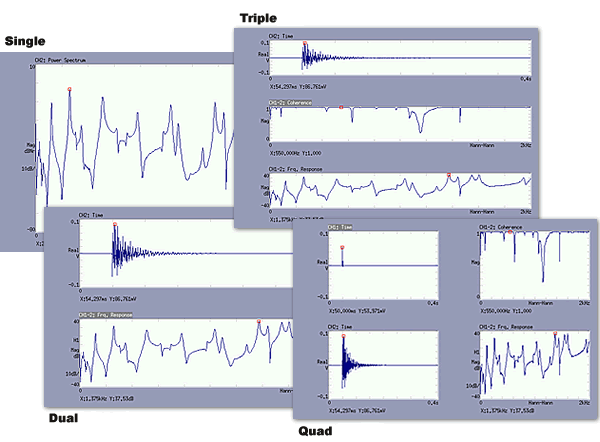제품사양
적용사례
기술자료
Portable 2-channel FFT Analyzer
CF-7200
In this easy-to-use FFT analyzer designed for modern needs, all aspects of the CF Series have been upgraded. With improved PC compatibility and a much smaller size of the main body, the CF-7200 delivers quick and easy measurement and analysis, yet with exceptionally high accuracy. Integrating all on-site needs into its compact body, the CF-7200 is a multifunctional high-performance analyzer that will become the de facto standard for the next generation.
Features
-
State-of-the-art Technologies and High Specifications, All in a Compact Body
| ■ Frequency range | 10 mHz to 100 kHz |
| ■ Voltage input range | 10 mVr to 31.62 Vr |
| ■ Data recording | 100 kHz range max., 2 channels |
| ■ Number of analysis points | 6400 points max. |
- Multiple Analysis Functions and Application Functions
Analysis Functions
| ■ Time-axis waveform | ■ Power spectrum |
| ■ Frequency response function | ■ Coherence Function |
| ■ Hilbert transform | ■ Inverse Fast Fourier Transform |
| ■ Cepstrum | ■ Tracking analysis (option) |
Application Functions
| ■EU function | ■Average Summation UNDO Function |
| ■Differential and Integral Functions | ■Waveform calculation |
| ■Zooming Analysis | ■Frequency Weighting Filters |
| ■Multi-screen | and more... |

-
Flexible Data Sharing
Accepts USB, Compact Flash Card, and other general-purpose interfaces for compatibility with PCs and easy data sharing in the existing environment.
-
Intuitive Button and Touch-panel Operations
The CF-7200 needs no mouse - simply press buttons for all operations. The clickfeel buttons and touch panel allow immediate operations ranging from start/stop of analysis to display of basic functions.
-
Lightweight, Compact and Highly Portable for All Sites
No setup needed before measurement or troublesome installation on site, such as connecting a personal computer, cables, and power supply to a measuring instrument. All functions necessary for measuring and analyzing noise and vibration are built into the CF- 7200's small file size, for greater flexibility on all sites.
Specifications
■ Input Section
Number of input channels |
2 channels |
||||||||||||||||
Input configuration |
Isolated single-ended |
||||||||||||||||
Input connector |
BNC (C02 type) |
||||||||||||||||
Power supply for sensor |
Supplies the current to a constant-current type sensor via a coaxial cable from the input connector (BNC terminal): +24V/4mA |
||||||||||||||||
IEEE1451.4(TEDS) |
Accepts an IEEE1451.4 (TEDS)-based sensor |
||||||||||||||||
Input impedance |
1MΩ ± 0.5% 100pF or less |
||||||||||||||||
Input coupling |
AC: -3dB at 0.5Hz or less
|
||||||||||||||||
Absolute maximum |
100VrmsAC for 1 minute (50Hz) |
||||||||||||||||
Amplitude voltage range |
|
||||||||||||||||
Input range step |
10 dB |
||||||||||||||||
Input level monitor |
OVER: Red LED ON (95% F.S. or more) |
||||||||||||||||
Auto range |
Whenever the 1-frame data is sampled, the amplitude voltage range changes automatically if input range-over occurs. |
||||||||||||||||
A/D converter |
16 bits |
||||||||||||||||
Dynamic range |
90dB or higher: +30 to -30dBVr range
|
||||||||||||||||
Harmonic distortion |
-80dB or less |
||||||||||||||||
Aliasing |
-80dB or less |
||||||||||||||||
Amplitude flatness |
20kHz or less ±0.1dB |
||||||||||||||||
Full-scale accuracy |
±0.1dB at 1kHz |
||||||||||||||||
Amplitude linearity |
±0.015% at full scale |
||||||||||||||||
Cross-talk |
-100dB or less |
||||||||||||||||
Channel to channel gain accuracy |
20kHz or less: ±0.1dB (0dBVr or less)
|
||||||||||||||||
Channel to channel phase accuracy |
20kHz or less: ±0.5deg (0dBVr or less)
|
||||||||||||||||
DC offset |
-60dB F.S.: Auto zero ON, +30 to -20dBVr range (DC coupling) |
||||||||||||||||
Trigger |
"TRIG ON" LED goes ON when trigger function turns ON Position: ±8191 ●External trigger
|
||||||||||||||||
Filter |
|
||||||||||||||||
External sampling input |
●BNC (C02 type) input: EXT SAMP Connector
●R03-R6F input: REV SENSOR Connector
|
||||||||||||||||
Remote control |
When the DS-0295 Remote Controller is connected, start/stop and custom-selection operations are possible. |
||||||||||||||||
Voice input/output for voice memo |
Sound input and playback with a built-in microphone and speaker External MIC input: φ 2.5 stereo mini jack input (L) |
■ Display Functions
Display mode |
SINGLE screen display mode/DUAL screen display mode/ TRIPLE screen display mode/QUAD screen display mode/OVERLAY display mode |
3D (color) Display |
●X axis |
List display mode |
Harmonic /Total Harmonic Distortion |
Label function |
Input: Direct handwriting using a stylus pen |
Search function |
Delta function X mode/Y mode/XY mode |
Vertical axis unit |
rms/PEAK/0-p/p-p/V/V2/PSD/ESD |
Vertical axis scale |
Auto/Manual/Default/Gain/Phase unwrap function/Delay |
Horizontal axis unit |
Hz/ r/min /Order (* under development) /s(sec)/EXT |
Horizontal axis scale |
Zooming with default/delta cursor |
Calculation function |
Differential and integral operations/FRF equalization/Inverse Fast Fourier Transform/ Hilbert transform/Damping calculation by half-value width method |
■ Display Unit
Size |
10.4-inch |
Type |
TFT color LCD with touch panel function |
Resolution |
800 x 600 dots |
Lighting (back light) |
Cold-cathode tube, 2-level brightness adjustment |
■ Analysis Section
Frequency accuracy |
±0.005% of reading (±50ppm) |
||||||||||||||||
Frequency range |
10mHz to 100kHz |
||||||||||||||||
Sampling frequency |
Frequency range x 2.56 (internal sampling) |
||||||||||||||||
Number of sampling points/analysis points |
|
||||||||||||||||
Overlap processing |
MAX/66.7%/50%/0%/Arbitrary setup |
||||||||||||||||
Window functions |
Rectangular/Hanning/Flat-top/Force/Exponential/User-defined |
||||||||||||||||
Delay function |
Time frame of channel 2 can be delayed by 0 to 8191 points with reference to channel 1. |
||||||||||||||||
Time-axis waveform processing function |
The time-axis waveform processing function can be selected with soft keys. |
||||||||||||||||
Real-time analysis |
40kHz/2 channels (internal sampling: 4096 points) |
||||||||||||||||
Search enhance |
Calculation resolution: x32 |
||||||||||||||||
Averaging mode |
Setting of number of averages: 1 to 65535
A/D-over cancel/Double hammer cancel/Averaging permission select function (ADD+1)/Averaging undo function |
||||||||||||||||
FFT operation |
32-bit floating point (IEEE single-precision format) |
■ Processing Functions
Time domain |
Time-axis waveform/Auto-correlation function/Cross-correlation function/Impulse response/Cepstrum/Liftered envelope/Hilbert transform |
||||||
Amplitude domain |
Amplitude probability density function/Amplitude probability distribution function |
||||||
Frequency domain |
|
■ Memory Functions
Data record |
|
||||||||||||||||
Data file |
Max. recordable memory capacity: 200 data items or less in internal memory/ CF card (depending on the CF card capacity) |
||||||||||||||||
File format |
Analysis data can be saved simultaneously with three different formats: DAT, TXT and BMP (TXT and BMP selectable). |
||||||||||||||||
Panel condition memory |
10 types |
||||||||||||||||
Contents of panel condition memory |
Memorizes parameters which can reproduce all software and hardware settings in the panel condition memory mode. |
||||||||||||||||
Voice memo memory |
200 data items or less (depending on the CF card capacity) |
||||||||||||||||
Handwritten memo memory |
200 data items or less (depending on the CF card capacity) |
||||||||||||||||
Recording device |
Main unit built-in memory (fixed) or CF card can be selected.
|
■ Output Functions
USB Interface |
|
||||||||||||
External SPEAKERoutput |
|
||||||||||||
Printer output |
Printer interface: USB |
||||||||||||
Monitor output |
Number of connectors: 2 (Each connector outputs Ch1 or Ch2 data) |
■ Signal Output (CF-0771) ― Option
Number of channels |
1 |
||||
Output connector |
BNC (C02 type) |
||||
D/A converter |
16 bits |
||||
Maximum output voltage |
±10V (Amplitude + DC offset) |
||||
Amplitude resolution |
Approx. 2.5mV |
||||
Offset resolution |
Approx. 5mV |
||||
Output format |
Unbalanced output |
||||
Protection circuit |
Short-circuit protection |
||||
Isolation |
No isolation (No isolation between chassis and digital common) |
||||
Output impedance |
0Ω: Low impedance output (unbalanced) |
||||
Output current |
50mA (If 10mA is exceeded, harmonic distortion, flatness, and crest factor are not prescribed.) |
||||
Output mode |
●Continuous ●Burst - Can be set from 1 to 32767 in 1-cycle steps ●Sine Sweep -Able to output using in combination with sweep average |
||||
Taper function |
The output can be gradually increased or decreased when the signal is turned ON or OFF. - Taper rising time: 1ms to 32s (in 1-ms steps) |
||||
Frequency range |
0.1mHz to 100kHz (sine wave) , Band limiting not possible |
||||
Harmonic distortion |
-70dB or less (Prescribed with 1V0-p amplitude value) |
||||
Output ON/OFF |
●Turned ON or OFF with the SIGNAL OUT button (Turned OFF at the time of activation) ●ON/OFF for each button
|
||||
Output waveform |
Sine wave, Swept sine, Pseudo random, Random, Impulse |
||||
Analysis frame length |
256 to 4096 |
||||
Zoom mode analysis |
Possible for all waveforms |
||||
Spectrum flatness |
±1.0dB or less: 20kHz to 100kHz |
||||
Crest factor |
Sine wave: Approx. 1.41 |
||||
Pink filter |
Analog filter: -3dB/oct ±1.0dB (prescribed for 20Hz to 20kHz) |
■ Miscellaneous Functions
Condition view |
List display of condition settings |
||||||||||
Remote controller (option) |
●Operating switches: 5 (START/STOP/F1/F2/F3)
|
||||||||||
Clock |
Date (year, month, day) and time (hour, minute, second) |
||||||||||
Operation beep |
Can be turned ON or OFF (in conjunction with ON/OFF of warning beep) |
||||||||||
Warning beep |
Can be turned ON or OFF (in conjunction with ON/OFF of operation beep) |
■ General Specifications
Power requirement |
Input voltage: 10.5 to 16.5VDC |
Power connector |
DC jack (EIAJ TYPE5) |
Power consumption |
Approx. 60 VA (AC adapter used) |
Operating temperature range |
0 to +40 °C |
Storage temperature range |
-10 to +50 °C (including an external secondary battery) |
Functional grounding terminal |
Grounding terminal for noise elimination |
Outside dimensions |
328mm(W) x 246mm(D) x 88mm(H) (battery not mounted)/328mm(W) x 246mm(D) x 120mm(H) (battery mounted)/Refer to outer dimensions for details |
Suspension of chassis |
VESA standard 100 x 100 (mm)/Can be suspended by attaching a φ 5 adapter |
Stylus pen |
Can be stored in the main unit (accessory) |
Carrying handle position |
0° (top level position)/30°/60°/90°/110°/130°/180° (bottom level position) |
Main unit cooling |
Forced-air cooling by an electric fan |
Weigh |
Approx. 3.5kg/Approx. 4.8kg (battery pack mounted) |
Standard Accessories |
?CF-0792 Battery Pack |
■ AC Adapter (SQ60W15P-03)
Input voltage |
100 to 240VAC |
Input frequency |
50/60Hz |
Output voltage |
Rating 15V |
Safety standard |
Electrical Safety Law/CE/UL |
■ Battery Pack (CF-0792)
Battery |
Lithium ion secondary battery |
Shape |
Fixed to the rear section of the main unit (detachable) |
Operating time |
Operates for 4 hours under standard operating conditions (2ch FFT analysis/Signal output option not mounted/25 °C room temperature with a new battery) |
Remaining battery level display |
Displays the remaining battery level when operating on the secondary battery 4-level display. |
Minimum remaining battery level |
Displays a warning message and shuts down automatically. |
Charge |
Charged by the AC adapter when the main unit power is OFF. |
Charge time |
Approx. 8 hours (power OFF) |
■ Options
Model Name |
Product Name |
CF-0722 |
Tracking Analysis Function (Order Ratio Analysis Function) |
CF-0771 |
1ch Signal Output Module |
CF-0701 |
Panel Protection Cover |
CF-0702 |
Stylus Pen |
CC-0025 |
Soft Carrying Case |
CC-0071A |
Hard Carrying Case |
DS-0295 |
Remote Controller |
Rack Mount Adapter |
■Recommended Products
Model Name |
Product Name |
BL-112UI |
Thermal printer |
HM-131 |
Speaker microphone |
|
|
 |
|
|
|
|
|
* Intended for sensors with a built-in constantcurrent type preamplifier. |
|
|
||||||||||||||||||
*Maximum record time at single time |
|
|||||||||||||||||
|
||||||||||||||||||
|
There are also connectors for connecting an external speaker and microphone, allowing you to create voice memos even in a noisy place. |
|||||||||||||||||
Analysis Functions
New Possibilities for Measurement and Analysis, from Laboratories to Production Sites
■ Time-axis Waveform
|
Performs A/D conversion of the raw waveform of an electrical signal of vibration, noise, pressure, strain, etc. coming from a sensor and then displays the result as time-domain data. The Xand Y-axis values at any point can directly be read using the search cursor. The delta cursor function makes it easier to read the time difference and level difference.
|
■ Power Spectrum
|
The power spectrum indicates the magnitude of frequency components contained in a sampled time-axis waveform. Frequency analysis enables detection of abnormal conditions of a facility, which are difficult to estimate through measurement of vibration and noise level and observation of raw timeaxis waveform. The natural frequency of a structure can also be measured.
|
■ Frequency Response Function
|
The frequency response function indicates the ratio of output to input and the frequency characteristics of phase difference. The resonant frequency and phase of a structure can easily be obtained accurately by entering the signal of vibration force generated to Ch1 by an impulse hammer or shaker and then inputting the response (signal of acceleration, velocity and displacement) to Ch2.
|
■ Coherence Function
|
The coherence function is for evaluating the linearity and correlation of input and output of a transmission system, obtained in the frequency domain. The rate of contribution of the input signal to the output signal is represented as a digit from 0 to 1 for each frequency, for evaluating the reliability of the frequency response function, locating a key factor from multiple noise and vibration sources, and evaluating the correlation.
|
■ Inverse Fast Fourier Transform (IFFT)
|
After frequency analysis, a time-axis waveform of a selected band can be obtained again by performing Inverse Fast Fourier Transform (IFFT) for the selected frequency band. For example, by selecting a waveform portion excluding an unnecessary frequency band confirmed in the FFT result and then performing Inverse Fast Fourier Transform (IFFT) for it, a time-axis waveform can be obtained with the selected high frequency band eliminated.
|
■ Hilbert Transform
|
A logarithmic damping factor can be obtained by obtaining a time envelope of a time-axis signal by means of Hilbert transform.
|
■ Cepstrum
|
Cepstrum is obtained by performing Fourier transform of the power spectrum again, allowing detection of the periodicity contained in the spectrum. In addition, reflected waveforms can be eliminated and fundamental frequency extracted by estimating a spectrum envelope from the Cepstrum. Cepstrum can be applied to make an analysis of the sound waves, seismic waves, biowaves, etc.
|
■ Tracking analysis (option:CF-0722)
|
Tracking analysis is effective for analyzing the noise and vibration in synchronization with rotational speed. This function enables to analyze which rotational speeds increase noise and vibration, which rotating parts cause this noise and vibration, and how many times of the frequency component of noise and vibration to the rotational speed occur. ■ Constant ratio tracking |
■ Rotational tracking analysis (option:CF-0722)
|
Equipments with built-in rotating machines, such as engines and motors in products like automobiles and office equipments, may have serious problem when the resonance between rotational equipment of rotating machine and each components will occur. This rotational tracking analysis helps greatly in cases like this. |
Calculation Functions
Multiple Applications with a Single CF-7200
■ EU Function
|
The CF-7200 FFT analyzer can not only directly read values as a voltage (V) but also as a physical quantity. When the input sensitivity has been set and calibration with a reference signal performed for each sensor, waveform values are converted to physical quantities when displayed, eliminating the need to convert from voltage values to physical quantities.
|
■ Average Summation UNDO Function
|
This function is used during average summation to UNDO one average summation. For example, if you end up with a bad result of summation in impulse hammer shaking, you can cancel the result data (by UNDOing the summation) and then try the summation again.
|
■ Differential and Integral Functions
|
First and second order differential operations and single and double integral operations are possible for time-axis and frequency-axis waveforms. Acceleration data from an acceleration sensor can be converted to velocity and displacement; and velocity data from a laser Doppler vibration meter can be converted to acceleration and displacement and displayed. When the EU function is used together, unit conversion (among "m/s2", "m/s" and "m") is also performed automatically.
|
■ List Display
|
This function displays a list of X-axis and Y-axis values for selected points on a displayed waveform. Numeric list for 40 points selected, peak value list and harmonic list enable numeric values to be simultaneously checked for multiple points. |
Display Functions
■ Multi-screen Display data can be arranged flexibly in the SINGLE, DUAL, TRIPLE and QUAD screen display modes.
|
|
■ Zooming Analysis In frequency analysis, zooming analysis is possible by selecting a central frequency. This function is useful for more detailed frequency analysis, for example, analysis of beating and other waveforms involving indistinguishable adjacent frequency components.
|
|
■ Frequency Weighting Filters Frequency weighting filters such as A, C and Flat weighting are provided. can be applied with A weighting and C weighting. This makes it easier to perform auditory sense correction in microphone-based acoustic analysis.
|
|
■ Sine Sweep Output Function By entering the signal from shaker, high-accurate frequency response function can be obtained with sweep average using in combination with signal output function of CF-7200.
*CF-0771 Signal Output module (option) for 1ch is required |
|
